With variable speed pumps dominating the pool industry on energy efficiency and savings, it is no surprise that manufacturers are improving the quality and the longevity of their variable speed pumps. Speck Pumps are taking things to the next level with their latest pump, the Badu EcoMV. The Badu EcoMV is Speck’s answer to the popular green revolution happening in variable speed pumps today. Inspired by German engineers, the Badu EcoMV is quiet and efficient, yet powerful enough to operate on a variety of pool sizes. So, what exactly makes the Badu EcoMV different than the other variable speeds being released? Is Speck’s Badu EcoMV variable speed pump for you? Let’s explore.
Speck Pumps is one of the leading international manufacturers of high-quality pumps used for industrial and commercial applications. A cool fact that you might not know is Speck Pumps actually had one of their pumps launched into space with American astronauts. Since the early 1900s, Speck Pumps has been a symbol of innovation, customization, and market-specific products. The Badu EcoMV is no exception.
Today, Speck is utilizing their commercial grade technology and quality and infusing them into their residential applications.
Why to Consider the EcoMV Variable Speed Pump
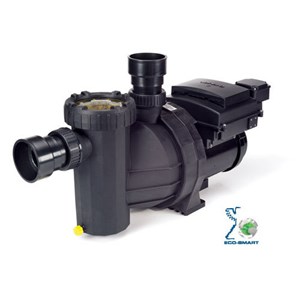 The Speck Badu EcoMV is a high performance, medium head pump that comes complete with a mechanical shaft seal unique to Speck. The shaft seal allows the pump to run dry for up to one hour. This is like a secret additional security measure for pumps that may have been mistreated or forgotten. The Badu EcoMV can be used in saltwater pools with a salt concentration of up to 5000 ppm. Additionally, the pump parts are made of 100% recyclable plastic. It is non-corrosive and chemical and UC resistant. It can also withstand temperatures of up to 175 F.
The Speck Badu EcoMV is a high performance, medium head pump that comes complete with a mechanical shaft seal unique to Speck. The shaft seal allows the pump to run dry for up to one hour. This is like a secret additional security measure for pumps that may have been mistreated or forgotten. The Badu EcoMV can be used in saltwater pools with a salt concentration of up to 5000 ppm. Additionally, the pump parts are made of 100% recyclable plastic. It is non-corrosive and chemical and UC resistant. It can also withstand temperatures of up to 175 F.
It is apparent that Speck truly cares about the longevity and lifespan of their products simply from the choices they made when manufacturing the EcoMV. It’s durable, lightweight, and non-corrosive. Each pump is tested before it leaves the Speck factory to minimize the number of defective pumps right out of the box. Even more, there is a two year manufacturer’s warranty on the motor and all pump parts, including normal wear of the mechanical seal.
The Speck Badu EcoMV has two different motor options. One runs at 2.4 total horsepower while the other runs at 3.4 total horsepower. Both operate the same.
Additional Features
- A lock ring that incorporates a handle to provide the user with a convenient way to remove the lid.
- 2” quick disconnect unions are provided with optional 3” unions available
- The impeller is made with a dielectric shaft sleeve that provides absolute separation between your pool water and the pump’s electric parts.
- It is equipped with a DC motor 2.4/3.45 THP US Motors’ EcoTech EZ motor with built-in controller and LCD screen.
- Freeze protection feature will run motor at 30% flow
- Keypad that can be locked for safety purposes
Usability
Usability is the means of making products and systems easier to use, matching them closer to user needs and requirements. In short, it is a product that a specified user can achieve specific goals with effectiveness and efficiency. So how does Specks EcoMV usability stand up to other pumps?
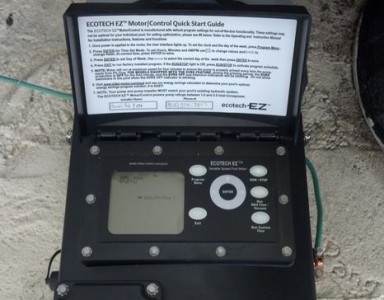 Overall, the EcoMV Variable Speed pump is simpler than other variable speed pumps with a controller. For instance, let’s look at the Pentair Intelliflo. The Intelliflo is a great pump that has the ability to program up 8 different speed settings. Who actually needs or uses the 8 different speed settings? My guess is not too many. The Speck EcoMV has fewer options and customizations therefore, less things to go wrong.
Overall, the EcoMV Variable Speed pump is simpler than other variable speed pumps with a controller. For instance, let’s look at the Pentair Intelliflo. The Intelliflo is a great pump that has the ability to program up 8 different speed settings. Who actually needs or uses the 8 different speed settings? My guess is not too many. The Speck EcoMV has fewer options and customizations therefore, less things to go wrong.
Programming the EcoMV pump is simple and straightforward for the average pool owner. You can program five different time settings for your pump: 2 settings for Monday-Friday, 2 for Saturday and Sunday, and 1 customary setting. In many cases, your pool pump is ran the same time every day, leaving you with well enough settings for your pool application.You can see better, in-depth instructions on programming the controller in the manual.
What the Customer Is Actually Saving
One of the first questions we often hear is, “How much money does a variable speed pump actually save me?” That is a valid question. Before making large purchases, customers often time compare the initial costs versus the overall costs down the line. Sometimes, paying more money up front will save you more money in the long run. This is the case for the Speck EcoMV Variable Speed pump.
Hawaii Case Study
A case study was done in Hawaii showing the amount of money a pool owner actually saved once they switched their current pump to the Speck EcoMV Variable Speed pump. In Hawaii, the cost of energy is very high at an average of $.36 per kWh. At the time, the pool had a 1 HP century pool pump operating their pool. Based on the specs on the motor label, it was determined that the pump was running at 230 V at 7.8 Amps. Let’s do some calculations together
- 1 HP operating at 1794 Watts (Volts x Amps or 230 x 7.8) Cost of Electricity – $0.36 per kWh
- Convert Watts to Kilowatts: 1794 W/1000= 1.794 KW
- 1.794 KW x $.36= $.65/ hr
- $.65 per hour at 8 hours a day= $5.17 per day to operate the pump.
Once the Speck EcoMV was installed on this customer’s pool, it was set to run at 8 hours a day at 30% (or 1035 RPM)
- The EcoMV operating at its lowest speed (1035 RPM) at 111 Watts. Cost of Electricity – $.36 per kWh
- Convert Watts to Kilowatts: 111 W / 1000 = .111 kW
- .111 kW X $.36 = 0.03996 = $.04 / hr
- $.04 per hour at 8 hours a day= $.32 per day to operate the pump
In this particular case study, when considering overall costs for the month, the pool owner was able to save approximately $145.50a month on their electricity bill by switching from a single speed pump to the Speck EcoMV Variable Speed pump. With these type of savings, you tend to earn the money you initially paid within the first 6 months of use. That is what we call true savings.
Speck Pump’s Badu EcoMV Variable Speed pump uses the “less is more” mantra. It’s construction is sturdy, reliable, and made with the intention to last over harsh weather conditions. It’s usability is streamlined and operates under minimal controls. Overall, the EcoMV has proven to be energy efficient and an easy way to save money on your electricity bill. For us, that is a win-win situation.
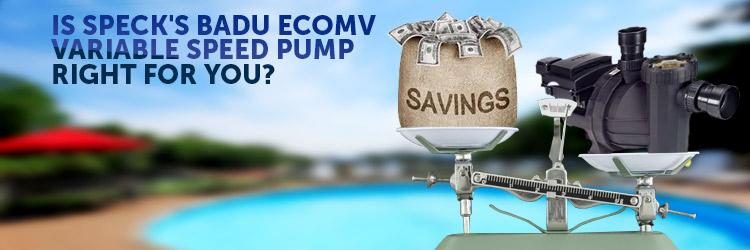
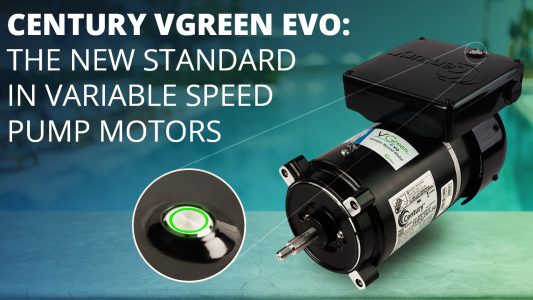
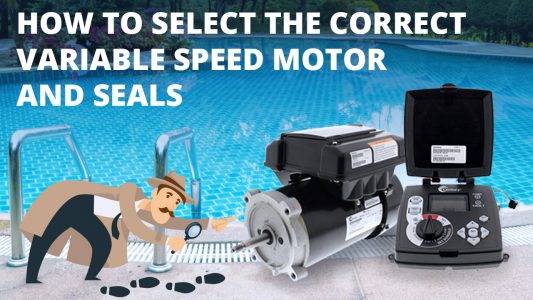
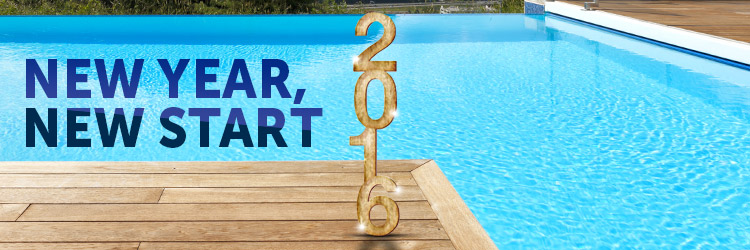
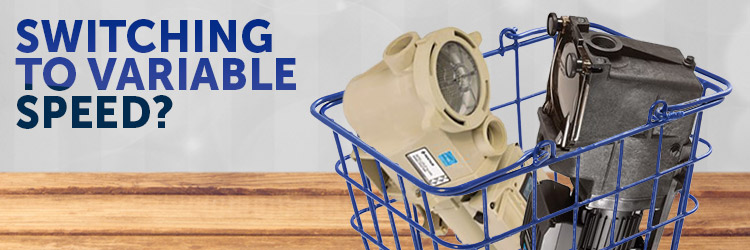






Are all variable pumps able to be used with saltwater pools?
That I know of, yes. The variable speed pumps use housing designs pulled directly from standard pool pumps, so they can be used in salt or traditional chlorine pools.
in my case I have a 1hp 2 speed motor in CA. I need the higher HP when using the pump to move the water through the solar blankets on the roof, but otherwise the lower speed setting seems sufficient. How would the variable speed help me and how would I set it?
The variable speed would permit you to run at a lower rpm than the dual speed’s 1725. The lower RPMs gives you big gains in savings, but you still have the ability to crank the motor to full speed when necessary.
if you are constantly running at a fraction of hp, why not just install a lower hp motor, or two speed and run at the lower speed
As your previous question on this article kind of answers it, I’ll just bring it up in an example. If you have a water feature or a solar panel that requires your motor to go full strength, then it is not a viable option to drop down to a lower HP. Plus the Law of Affinity basically means that the RPM and power usage are not on an equal Scale. So a dual speed’s low speed is half the RPMs but its amps are an eighth. So the lower you go on the RPM scale, the more and more you save.
This case study is flawed. a 1 Hp motor only operates at about 745W not the 1794W claimed in the study which is almost 2.5 times more than actual. And why does the 1Hp operate for 8 hrs and the variable speed operate for 7 hrs. How many gallons were moved in each example. Please do apples to apples comparison and don’t sensationalize the numbers by using electrical rates from Hawaii. Why use Hawaii when most of USA customers are paying closer to $0.10/kwh on average. Hawaii is more than 3x the cost compared to the mainland average.
Hello Jerry, thanks for the comment. First, I will spot you, that we probably should have used a different state than Hawai’i in our example because of their high utility rates. Their kWh costs can skew the numbers a bit. Also, we should have compared them both using 8 hour time periods. We are going to adjust the time periods and calculations in the blog for a better comparison.
We’ll have to agree to disagree on your wattage calculation. The formula for watts is shown in the article, but I’ll repeat it, Volts x Amps:
If you have a running 230 volts to a single speed motor that pulls 7.8 amps,
The formula would go, as such: 230 x 7.8,
The product for that calculation is 1,794
Even with the adjusted run time from 7 to 8 hours, the EcoMV costs $.32 a day to operate. According to my meager math skills, $.32 is quite a bit less than $5.17.
Hi Matthew, You are very wrong in your calculations!
I’m not going to redo your calculations but Jerry is 100% correct.
According to you the 1,794 W…?? (is that DC?) will imply the max power of the motor = 2.392 HP not
1HP (I used 1Hp = 750W).
So this is a marketing issue nut a scientific explanation.
“How many gallons were moved in each example?”
Best regards,
Tony
Tony and Jerry, unfortunately your comments are disappointing as you are failing to realize power consumption/draw of the pump vs work generated. Matthew’s calculation is correct, a 1HP pump which is 230V that pulls 7.8 amps will consume about 1.79 KW/hr. The work created by the pump will be 1HP or 745KW. The rest are losses like heat, noise, friction, etc….
My largest point of contention with the calculation is a pull must be based on water turn over with at the volume of the pool turned over at least 1 time per day preferably 1.5 times. In all likelihood, the variable speed pump must run at least 2 times as long as the single speed pump. This will eat into the savings although still sizable and most don’t have Hawaii’s energy costs.
What’s the warrant? What’s the qualifications on the warranty? (Pentair has a 3 year warranty unless it’s a DIY install (not rocket science by any measure) then it 60 days.
Are the technical service manuals and replacement parts available?
Hello, the Speck Badu EcoMV’s Owner’s Manual contains all the warranty information in section 4. Take a peek. The EcoMV has a 2-Year limited warranty.
The owner’s manual should cover servicing and troubleshooting but if you need further help, refer to Inyo’s How-to Guide Section. The EcoMV parts are available, and we are in the process of adding the parts breakdown to our pool pump parts page.